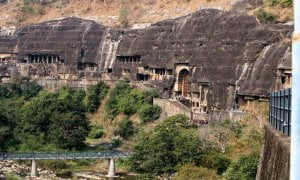Tourism Policy formulation Bodies in India: There are many bodies/organisations involved in the process of Policy formulation in the country, each organisation aims at framing successful and effective policy for the development and expansion of tourism across all parts/regions of the country.
Policies are framed for the benefit of the residents of the country, with the vision to develop tourism as a major source for the overall benefits both socio-cultural and economic. following are the organisations/Bodies involved in tourism Policy formulation.
1. Ministry of Tourism, Government of India
The Ministry of Tourism, Government of India is the principal organization involved in the the creation of national policies and programmes and also looks after for the coordination of actions of different Central Government Organisations, State Governments/UTs and the Private Sector organisations for the expansion and publicity of tourism in the country.
Also read Role of a Tourist Guide
This Ministry is lead by the Union Minister of State for Tourism. The governmental head of the Ministry is the Secretary (Tourism). The Secretary also works as the Director General (DG) Tourism. The office of the Director General of Tourism {now combined with the office of Secretary (Tourism) offers management guidelines for the execution of different plans and policies.
Directorate General of Tourism has a field foundation of 20 offices throughout the country and 14 offices outside India and one sub-ordinate workplace/project i.e. Indian Institute of Skiing and Mountaineering (IISM)/ Gulmarg Winter Sports Project. Tourism Policy formulation Bodies in India
The foreign offices are mainly liable for tourism advertising and promotion in their particular areas and the field offices in India are liable for delivering info facility to tourists travelling around the country and to look after the growth of field projects.
Also read Emergence of Sustainable Tourism
The actions of IISM/GWSP have now been renewed and different Ski and other development programmes are being organised or conducted in the J&K valley. The Ministry of Tourism has under its concern a public sector organisation, the India Tourism Development Corporation and the above self-governing institutions:
- Indian Institute of Tourism and Travel Management (IITTM)
- National Institute of Water Sports (NIWS)
- National Council for Hotel Management and Catering Technology (NCHMCT)
- The Institutes of Hotel Management.
Role of Ministry of Tourism Government of India
- Development and formulation of Policies and programs.
- Providing Incentives plans for tourism projects.
- External Assistance to major tourism development projects.
- Training and Development of workforce in order to fulfill the industries requirement.
- Promotion & Marketing both in India and abroad.
- Providing financial assistance for for Investment in tourism projects.
- Planning and Co-ordination with other Departments, Ministries, State/UT Governments for the development of tourism sector in India. Tourism Policy formulation Bodies in India
- Setting up of rules & regulation or minimum Standards and Guidelines.
- Focus on developing Infrastructure & enhancing Product Development.
- Creation of infrastructure and facilities like institutes and training centers for HR Development
Also read Sustainable Tourism
- Monitoring, Evaluation, Research, Analysis on tourism industry
- Focused towards International Co-operation and External Assistance and collaborations with foreign technical organizations
- Bilateral Agreements with other nations for the growth of tourism.
- Providing Budget and co-ordination and related matters for the development of tourism.
- Assist in the making of policies by offering response from the field offices all over the globe.
- Examining of Plan Projects and supporting in the Plan formulation for expansion of the industry
- Coordinating with the actions of field offices and their management Giving authorization and categorization of hotels and restaurants.
- Giving authorization of travel agents, tourist transport operators and Inbound tour operators etc.
- Infrastructure Development throughout the various destinations in the country.
- Tourist facilitation and information.
- Hospitality programs.
- Conventions & conferences.
2. Planning commission of India
Tourism development in India began quite late with the first tourism policy being declared by the Government of India in year November, 1982. tourism was known as an industry by the Planning Commission of India in the year June, 1982. In the year July, 1986 the Planning Commission of India established the National Committee on Tourism with the aim to frame plans for the tourism sector.
Also read Types of Tourism
The government’s plans of integrating a planned tourism sector in India moved an extended way in encouraging Indian tourism. In the year May, 1992 the National Action Plan for tourism was declared. The goals of this milestone plan for tourism development in India were:
- To develop the budget group domestic tourism
- To grow the tourist regions both economically and socially
- Conservation of the national heritage and the environment of the country
- To encourage the movement of foreign tourists in the country
- To progress India’s share in the world tourism
- To exhilarate chances for job opportunities in the tourism sector:
India tourism development amplified with the 7th five-year plan in India (1985-1989). The different polices revived by the 7th plan for tourism planning in India are:
- To motivate uncompromisingly domestic tourism movement in the country
- Focused more on constructing extra beach resorts
- Aimed at conducting/organising conferences, trekking, conferences, and winter sports so that diverse choices are presented to the international tourists
Also read Technological Advancements in Tourism in the 21st Century
These polices of the 7th five-year plan provided an increase to the tourism planning India. For furthermore growth of tourism in India, tourism planning in India, the eighth fiveyear plan (1992- 1997) stated that the private sector must expand its contribution in the tourism sector. The different polices supported by the 8th plan for tourism planning in the country are:
- Development of different tourist’s places in the country
- Focused on developing winter sports, wildlife tourism and beach resorts.
- Restoration and preservation of national heritage in the country
- Providing tourist’s centres with economical type of accommodation
Tourism planning in India has improved by up and downs in the last past years and the government and Department of Tourism have to make non-stop plans and policies to guarantee that tourism planning in India can take the Indian tourism industry to larger heights on a sustainable base. Tourism Policy formulation Bodies in India
The National Institution for Transforming India is a Government of India plan think-tank founded by the Narendra Modi government to substitute the Planning Commission which charted the top-down model.
The specified aims for NITI Aayog’s formation is to nurture participation and contribution in the fiscal policy-making technique by the State Governments of India. The stress is on bottom-up approach and make the country to move near to cooperative federalism.
Also read Tourism in the 21st Century
3. The National Development Council
The national Development council was established in the year August 1952, also called as the Rashtriya Vikas Parishad. NDC is a head body for decision making and planning on the growth and development matters in the country.
The main role of the body is to strengthen and mobilize the resources and efforts of the nation in support of planning and also focuses on promotion of common economic policies in all important stages, also ensures and a keep a check on rapid and balanced growth and expansion in all the parts/regions of the country.
The National Development Council also makes sure in the process of Indian growth and planning. It provides chances to both the Union minister s and the Chief ministers of the States to discuss on the different strategies at important stages of their policy making.
The policies and plans are finally sanctioned or approved at their gathering/meetings after the accomplishment and before they are finally presented in the Parliament and the State legislatures.
In this manner the national effectiveness of the policies and plans is highlighted. The Council also studies economic and social programs disturbing the country from view point of the citizens of the country, so that where needed standardisation may be safe. In different ways, it gives a clue to the Country on wide-ranging problems of policy and encourages joint philosophy and mutual act on problems of national importance.
The National Development Council called its first meeting in the year November 1952. Meetings normally last for two days. The first meeting focused on the Draft Report of the First Five-Year Plan. The various phases of the Second Five-Year Plan were studied at four meetings starting from May 1955, at which the Plan-frame and provisional structure were studied, and ending in May 1956, at which the final report was accepted.
The Council studied propositions linking to the Third Five-Year Plan at six meetings in March, April, September 1960 and January, March and May 1961. At the initial meetings, patterns of development, financial resources and divisions to different sectors were pondered on the basis of papers circulated by the Commission. The Draft Outline was sanctioned at the meeting of September 2 1960 and the Report of the Third Plan in May 1961.
Also read Driver of Travel and Tourism in 21st Century
Other gatherings contemplated progress report on land reforms, co-operative policy, Plans, agriculture problems, problems relating to community development etc. In vision of the importance of agriculture production and price policy, two special gatherings of National Development Council were held to report these questions.
The importance of the issues that are placed before the Council from time to time is thus clear. It may be stated that between 1955 and 1958 for about three years, a standing committee consisting of 9 to 12 States had been created by the National Development Council. This body held together six meetings.
In 1958, the Standing Committee was dropped as, under the reform of States, the total number of States had been condensed and there was no requirement for a minor body.
Objectives and Functions of NDC
- To protected support of all the states in the implementation of the plan in different sectors
- Focus on strengthening and activating the work and resources of the country in the support of the Policies and plans
- Promotion of the mutual economic plans and policies in all important domains
- Keep a check and ensure there is stable and fast growth in all the parts of the country.
- Prescribe guidelines for the preparation of The national plans and policies plus the evaluation of the resources available for the Plan.
- To study the National Plan as prepared by the NITI Aayog.
- Creating an evaluation of the resources that are essential for executing the Plan and to recommend actions for strengthening the plans.
- Focus on study principal questions of social and economic program disturbing national development.
- Review the functioning of the Plan on regular time intervals and to advise such actions which are essential for accomplishing the goals and objectives fixed out in the National Plan.
- Giving recommendation actions for accomplishment of the goals and objectives fixed out in the national Plan.
4. Inter State Council
The Inter State Council is an Indian constitutional organisation set up on the basis of provisions in Article 263 of the Constitution of India. The organisation was established by a Presidential Order dated on 28 May 1990 on suggestion of Sarkaria Commission.
The Council is designed for discussing or examining policies, subjects of common interest, and disputes amongst the different states of the country.
Tourism Policy formulation Bodies in India
Article 263 of the Indian Constitution offers for formation of Inter State Council (ISC). It is not a permanent organisation. It can be formed ‘at any time’ if it shows to the President that the public interests would be functioned by the formation of such a type of Council. Yet, with increasing gap amongst centre and states.
Also read Cost-Benefit Analysis Technique for Tourism Development
The main functions of ISC
- Works on solving clash of interest amongst center and states by discussion and mutual act.
- ISC can issue a consent on part of Governor.
- Also can choose upon the usage of article 356 and other such constitutional matter
- Other objections of states like flowing of items from state to concurrent list can be expressed.
- Work on bridging the trust shortage among the center and states.
- Make decisions on deciding the on decentralization of funds.
- ISC is also a stage for the health discussions and conversation.
- Judiciary can choose on problems disturbing center-state affairs on a case to case basis. It marks in important directorial and financial cost as in the case of recent Uttarakhand and Arunachal Pradesh crunch. ISC can stretch a agreement on such problems before so that disaster like circumstances does not occur.
- Center has selected powers to exchange with foreign government and funding agencies. ISC will offer a proposal to bring states on board too.
- Promotion of healthy contest amongst states.
Tourism Policy formulation Bodies in India





